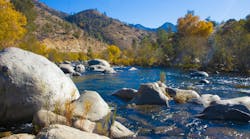Rainwater harvesting is the practice of collecting rainwater, rather than letting it run off, and then reusing the water later.
Rainwater harvesting is a sustainable green infrastructure solution, but regulations for the method are not consistent across the country.
How does rainwater harvesting work?
First, before installing rainwater harvesting systems, it is important to understand the regulations of the area in which you live. The Pacific Northwest National Laboratory (PNNL) partnered with the Federal Energy Management Program (FEMP) developed an online GIS tool, the Rainwater Harvesting Tool, which provides state-by-state rainwater harvesting regulations, rainwater harvesting potential for year-round collection and rainwater harvesting potential for landscape irrigation.
Once you understand the regulations, a rainwater harvesting system is needed, and this can range in size and capabilities. According to the Texas A&M Agrilife Extension, “all systems have basics components, which include a catchment surface, conveyance system, storage, distribution, and treatment.”
The catchment area is the first stop for the rainfall, as it is often the system roof. The rain will then flow to the conveyance part of the system, which consists of gutters and downspouts. Following the conveyance system, the rainwater then hits the storage container where it is stored for later use before finally reaching the treatment and distribution areas when needed.
What are the advantages of rainwater harvesting?
When rainwater is harvested, it can be used for myriad reasons, including but not limited to:
- Meeting stormwater management regulations
- Reducing stormwater runoff
- Recharge groundwater
- Landscape irrigation
- Toilet and urinal flushing
Perhaps one of the most well-known advantages of rainwater harvesting is the removal of pollutants. As rainwater hits the ground and travels along impervious surfaces, it picks up pollutants, such as sediment, fertilizers, and litter, and carries them into waterways. Through rainwater harvesting, the rainwater is caught and treated before being released back into the environment, thus reducing the number of pollutants that reach waterways.
What are the disadvantages of rainwater harvesting?
As stated above, rainwater regulations are not consistent throughout the states, which may be a barrier to implementing the practice.
Additionally, some rainwater harvesting systems can be costly and require regular maintenance, both of which can be additional barriers, and of course, rainwater harvesting needs rainwater to work. The weather is unpredictable, with no guarantee the area you live in will have enough rainfall to make a system worth it.
How effective is rainwater harvesting?
The effectiveness and worth of rainwater harvesting depends on what your goals are.
With a mix of advantages and disadvantages, like a lot of stormwater management practices, rainwater harvesting can be worth it. Some states, including New Mexico, Texas, and North Carolina, offer incentive programs for rainwater harvesting if water filtration systems are installed.
According to a recent Forbes article, rainwater harvesting is “often the most affordable source of freshwater. However, if you simply want to save water, you can cut household usage by taking shorter showers, installing low-flow toilets and showerheads, only washing full loads of laundry and watering plants in the early morning or evening.”
Conclusion
To conclude, rainwater harvesting is not a one-size-fits-all practice, but it is a viable and sustainable option in areas where it is legal. While its upfront costs can be high, it may be worth it in the long run.
About the Author
Katie Johns
Editor-in-Chief
Katie Johns, editor-in-chief of Stormwater Solutions, graduated from the University of Missouri in 2016 with a Bachelor of Journalism and a Bachelor of Arts in Spanish. Johns joined the Stormwater Solutions team in September 2019. Johns also helps plan the annual StormCon conference and co-hosts the Talking Under Water podcast. Prior to entering the B2B industry, she worked as a newspaper reporter and editor in Sarasota, Florida, and a magazine assistant editor in the Chicago suburbs. She can be reached at [email protected].



